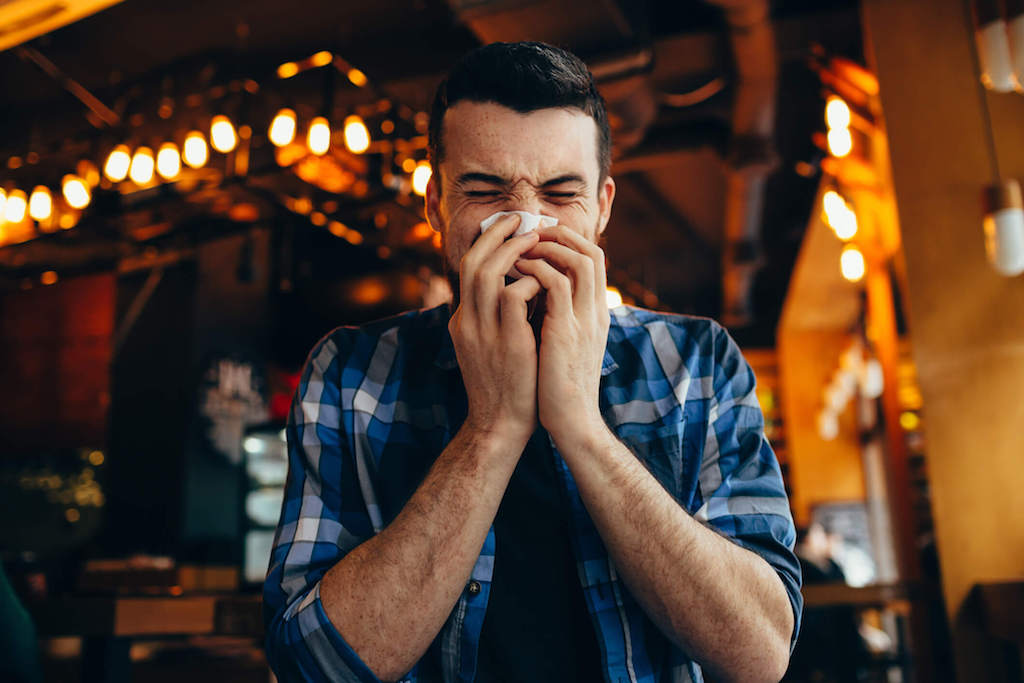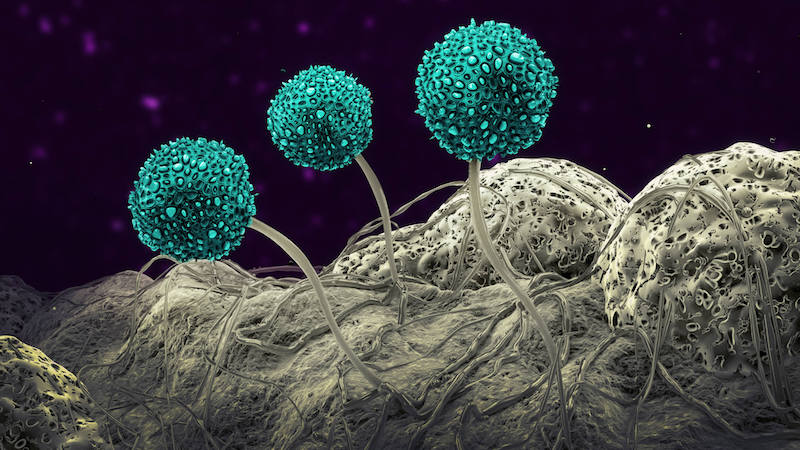Think about where you physically are during a typical day. For most of us, the majority of our time is probably spent at work, at home, or in the car. Any leisure time may be spent at home or out and about at restaurants, movie theaters, or coffee shops.
All of these places have one commonality. They’re all buildings that we go inside of. As a result, we spend the majority of our time indoors. In fact, the EPA says that the average American spends 90 percent of their time inside.¹

Do you fall into that statistic? Chances are, you probably do!
Now factor in how much of that indoor air you breathe in every day. Circling back to the EPA, they say that the average person takes 20,000 breaths a day.² That comes out to about 833 breaths an hour and 13 breaths a minute.
At this point, you might be thinking, "Okay, thanks for that math lesson. So what?"
What if the air you’re breathing in is filled with invisible, harmful particles? And every time you take a big inhale, those microscopic particles fly straight into your nose or mouth and land inside of your body. Oh, and they can cause serious health effects depending on your particular sensitivity levels and what particles you’re exposed to.³
That’s the importance of indoor air quality and mold awareness! Otherwise, you never know what you’re breathing in places like your favorite restaurant.
Where The Focus Is
As a society, we generally don’t factor in indoor air quality when it comes to helping create a good bill of health. At least not yet! There have been numerous studies and information published regarding indoor air quality, but no massive movement towards creating safer indoor spaces for all.⁴ It’s a bit odd considering that we intake more air than anything else that may impact our general well-being. Way more than even food and water. So why are we not more concerned with what we’re breathing into our bodies?
It’s puzzling, right! At the moment, we’re indoor air quality adjacent when it comes to being concerned about what we’re breathing in. For years, scientists and media outlets have worked hard to focus on outdoor air quality and how poor outdoor air can affect our health. Which is incredibly important as well! There is a slew of studies pointing to the relationship between outdoor air pollution and adverse health effects, and measures taken by the government attempting to remedy any pollution problems.⁵’⁶

But this focus rarely extends to the other 90 percent of the air we’re breathing in. If you really think about it, when’s the last time you heard anything about indoor air quality or considered how it was affecting you? What’s actually in all of that air besides oxygen our bodies need? Anything could be floating around!
For instance. What if mold spores or mycotoxins are hanging out in the air and making their way into our bodies? That’s not exactly adding to a healthy lifestyle. Unfortunately, indoor mold exposure also falls into the category of neglected attention and works with indoor air quality.
Currently, no Occupational Safety and Health Administration standards exist for indoor air quality or indoor mold.⁷ This means it’s up to us to create better awareness and safer indoor environments so we can breathe clean, healthy air. Particularly in public spaces like restaurants, where the opportunities for contamination are even higher.

Air Quality and Health
Several factors influence indoor air quality, like the presence of viruses and bacteria, but the main issue is particulate matter (PM), which is the volume of tiny particles and liquid droplets in the air.⁸ Many molecules, like organic matter, dust, and sulfates, fall into the particulate matter category as long as they tick one box: they’ve got to be tiny. Really, really tiny.
The EPA separates PM into two categories: inhalable and fine inhalable.⁹ So essentially, these particles are small enough to float throughout the air and land in our lungs.
Some particles are so small, they can even make it into the bloodstream. This fuels their ability to cause a range of health effects.¹⁰
Depending on an individual’s sensitivity level, they could experience symptoms such as:
Those with pre-existing conditions or developing immune systems, like the elderly and children, are particularly susceptible to poor air quality and the side effects that go along with it.
With a revolving door of individuals and the functionality of the space, it’s easy to see how the air in public places like restaurants can easily become contaminated.
Air Quality in Public Spaces Like Restaurants
Once we all jump on the indoor air quality bandwagon, we can start improving our living spaces so that we’re in clean, healthy environments. What about when we’re in public spaces, though? With so little in the form of standards, it’s up to each establishment to determine how they want to protect those inside from poor air quality.
As the Coronavirus pandemic drags on, many public places like restaurants are working hard to puzzle out how to keep their occupants safe. That includes improving the indoor environmental conditions of the building, like air quality. While the circumstances triggering this event are harrowing, the general movement towards improving air quality is definitely a step in the right direction.
Public spaces like restaurants are inundated with particles from the mass of people coming in and out, constant cooking of food in the kitchen, repetitive bathroom use, and endless beverage filling. There are limitless opportunities for bacteria, viruses, organic matter, mold spores, and toxins to enter the indoor space.
All of these particles are then breathed in by the many individuals inside the building. With the adverse health effects that can be triggered from exposure, restaurants and other public spaces need to take proactive measures to remove these contaminants from their air so guests and staff can enjoy the space safely.

That includes ensuring ventilation mechanics are operating correctly, utilizing purification technology like air purifiers, and regularly cleaning top-to-bottom.
Creating better air quality also includes stopping additional contamination opportunities from things like mold growth.
Mold Growth in Public Spaces Like Restaurants
Mold is a type of fungus that reproduces by creating microscopic spores that it releases into the air.¹¹ When these spores find a damp environment, they settle in to grow and colonize. Once established, they release even more spores into the air to start the cycle over again.¹²
With over a hundred thousand species identified so far, it’s easiest to say that mold spores are pretty much everywhere—outside in nature, inside a car, floating in your bathroom, and even attached to your dog. The problem occurs when that damp, habitable location is inside your home. The more the colonized mold grows, the more spores it releases into the air. A higher volume of spores in the air drastically impacts the air quality, which sparks those adverse health reactions.

Some mold species can also create microscopic toxins, called mycotoxins, that they release into the air along with the spores.¹³ These tiny toxins similarly cause a range of side effects.
With most mold spores only needing oxygen, food sources, temperatures between 40-90 degrees Fahrenheit, and water, it’s fairly easy for them to start growing inside.¹⁴ If they find a spot that’s wet for over 24 hours, that is.
In places like restaurants, where the general space is bombarded with moisture, mold can easily find a home. Once growth begins, the air quality correspondingly drops and more mold spores can opportunistically find other damp areas to start colonizing. That can quickly lead to a massive mold and air quality fiasco.
Less research has been done on mold exposure, but researchers are hard at work trying to determine exactly how this fungus and its byproducts affect health. Generally, though, it’s agreed that mold exposure can cause a range of side effects depending on the individual.¹⁵’¹⁶
Creating Safe Indoor Environments
While we can all do our part to decrease these moldy opportunities in our own homes, it’s up to building owners and managers to ensure public spaces like restaurants are safe for anyone inside. As guests, we can make suggestions and do our homework to make sure they actively attempt to promote clean air, but at the end of the day, it’s their decision how far they want to go to improve their space.
However, what we can do is offer encouragement and support so these establishments are aware of and understand our concerns about air quality. The first step to change is acknowledging that there’s a problem. From there, we can all work towards creating healthy air quality for all.
- Environmental Protection Agency. (n.d.). Indoor Air Quality. EPA. Retrieved October 8, 2021, from https://www.epa.gov/report-environment/indoor-air-quality#:~:text=Americans%2C%20on%20average%2C%20spend%20approximately,higher%20than%20typical%20outdoor%20concentrations.
- Brown, A. (2014, April 28). How Many Breaths Do You Take Each Day? [web log]. Retrieved October 8, 2021, from How Many Breaths Do You Take Each Day?
- EPA. (n.d.). Health and Environmental Effects of Particulate Matter (PM). EPA. Retrieved October 8, 2021, from https://www.epa.gov/pm-pollution/health-and-environmental-effects-particulate-matter-pm.
- Samet, J. M., Marbury, M. C., & Spengler, J. D. (1987). Health effects and sources of indoor air pollution. Part I. American Review of Respiratory Disease, 136(6), 1486-1508.
- Kampa, M., & Castanas, E. (2008). Human health effects of air pollution. Environmental pollution, 151(2), 362-367.
- Bernstein, J. A., Alexis, N., Barnes, C., Bernstein, I. L., Nel, A., Peden, D., ... & Williams, P. B. (2004). Health effects of air pollution. Journal of allergy and clinical immunology, 114(5), 1116-1123.
- Occupational Safety and Health Administration. (n.d.). Indoor Air Quality - Overview | Occupational Safety and Health Administration. United States Department of Labor. Retrieved October 8, 2021, from https://www.osha.gov/indoor-air-quality.
- Kim, K. H., Kabir, E., & Kabir, S. (2015). A review on the human health impact of airborne particulate matter. Environment international, 74, 136-143.
- EPA. (n.d.). Particulate Matter (PM) Pollution. EPA. Retrieved October 8, 2021, from https://www.epa.gov/pm-pollution.
- Regional Office for Europe, Health Effects of Particulate Matter 1–15 (2013). WHO.
- Environmental Protection Agency. (n.d.). Mold. EPA. Retrieved August 17, 2021, from https://www.epa.gov/mold.
- Centers for Disease Control and Prevention. (2020, August 11). Basic facts about mold and dampness. Centers for Disease Control and Prevention. Retrieved August 17, 2021, from https://www.cdc.gov/mold/faqs.htm.
- World Health Organization. (n.d.). Mycotoxins. World Health Organization. Retrieved August 26, 2021, from https://www.who.int/news-room/fact-sheets/detail/mycotoxins.
- Lstiburek, J., Brennan, T., & Yost, N. (2002, January 15). Rr-0208: What you need to know about mold. Building Science Corporation. Retrieved August 18, 2021, from https://www.buildingscience.com/documents/reports/rr-0208-what-you-need-to-know-about-mold/view.
- Bush, R. K., Portnoy, J. M., Saxon, A., Terr, A. I., & Wood, R. A. (2006). The medical effects of mold exposure. Journal of Allergy and Clinical Immunology, 117(2), 326-333.
- Environmental and Occupational Health Assessment Program, & Environmental and Occupational Health Assessment Program, & Health Science Section, Mold Basics for Primary Care Clinicians (2009). Hartford, CT; Connecticut Department of Public Health. , H. S. S., Mold Basics for Primary Care Clinicians 1–10 (2009). Hartford, CT; Connecticut Department of Public Health.

